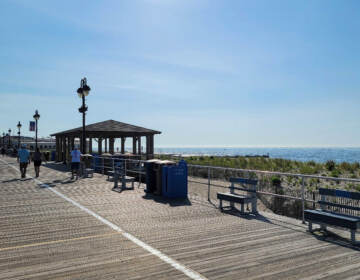N.J. beaches ‘in great shape,’ water quality ‘excellent,’ official says
Memorial Day weekend is upon us, so the Jersey Shore is "officially" open for the summer season, and state officials say the coast is ready.

A beach entrance in South Seaside Park. (Justin Auciello/WHYY)
Memorial Day weekend is upon us, so the Jersey Shore is “officially” open for the summer season, and state officials say the coast is ready.
At the 17th annual “State of the Shore” event in Asbury Park on Thursday, New Jersey Department of Environmental Protection Commissioner Catherine R. McCabe said the beaches are in great shape and the water quality is excellent.
Speakers at the gathering, hosted by the New Jersey Sea Grant Consortium, provided a status report on water quality, beaches, and other coastal issues.
McCabe noted that beach erosion during the fall and winter seasons, traditionally stormy months, was minimal, adding that beaches are generally wider and dunes higher after an extensive replenishment project in northern Ocean County, an area pummeled by Superstorm Sandy.
The commissioner said that ocean and bay water quality, with only four beach closures in 2018, remains great, with the closings last summer due to runoff after heavy rainfall.
During the summer season, the state routinely tests water quality at 188 ocean beaches, 20 bay beaches, and eight river beaches.
The state also conducts coastal surveillance flights that operate six days per week from mid-May to mid-September, weather permitting, looking for issues such as excessive algae blooms or debris that might affect water quality.
You can check water quality at your local beaches here.
Dr. Amy Williams of the New Jersey Sea Grant Consortium urged the public to only swim at guarded beaches and learn about rip currents.
“More than 80% of surf-related ocean rescues are attributed to rip currents,” she said. “It is critical that swimmers not panic if caught in one and that they swim parallel to the shoreline until they are no longer in its grasp. At that point, they should be able to swim safely back to shore.”
WHYY is your source for fact-based, in-depth journalism and information. As a nonprofit organization, we rely on financial support from readers like you. Please give today.




